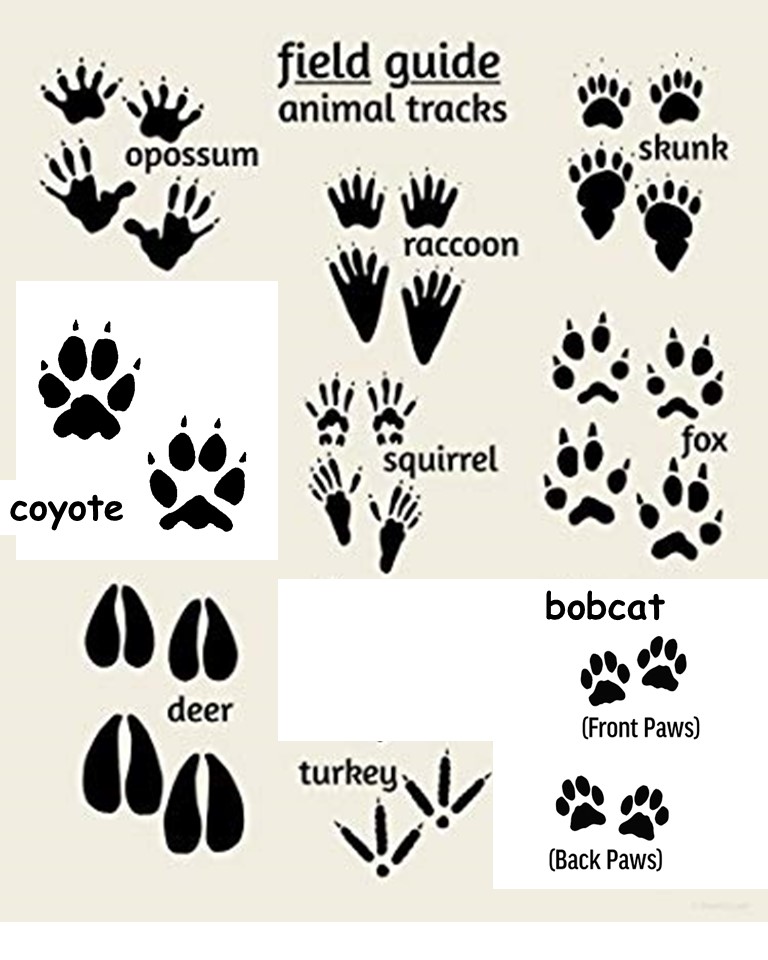Animal Tracks

Winter and snow bring the opportunity to discover an abundance of animal tracks, turning a simple path into a deer superhighway. It’s fascinating to see where the critters go in their travels in the woods. Perhaps they feel the same way when they see our footprints or UTV tracks.
Let’s take a look at some of the most common animal tracks found in our area and learn about the critters that leave those tracks:
Bobcat (Lynx rufus): Bobcats have a ruff of fur extending from the ear to the lower jaw, tufted ears, long legs and a bobbed tail (4 to 6 inches). Bobcat tracks are round and do not have claw marks, as their claws are retractable, like all felines. Front prints average one and three-fourths to two and one-fourth inches long, with rear prints slightly smaller.
Coyote (Canis latrans): Coyotes are 23 to 26 inches high and three to four and a half feet long. They typically weigh 20 to 40 pounds, but can reach 55 pounds. Illinois coyotes are usually larger than those from the western U.S. Coyote, and most other dog tracks, are longer than they are wide and claw marks are almost always visible for canines cannot retract their claws. Front prints average two and one-fourth to two and three-fourths inches long and one and three-fourths to two and three-eighths inches wide, with rear prints slightly smaller.
Red Fox (Vulpes vulpes): Red fox tracks show four toes and claws. The foot of the red fox is covered with hair, so toes can be indistinct. Red foxes have callous pads on their toes that sometimes show up in the prints. There is also a chevron-shaped callous pad on the heel pad of the foot. No other canine has this, which makes identification of the red fox track easier. Red fox footprints generally measure one and three-fourths to two and one-half inches long by one and one-half to two inches wide.
White-tailed Deer (Odocoileus virginianus): The print of a deer’s cloven hoof is a split heart shape. There are no other wild animals that make similar tracks in Illinois. Most tracks are between two and three inches long on hard ground. On soft ground, the dewclaws (functionless digits above the true hoof) may also make a mark.
Raccoon (Procyon lotor): Raccoon tracks may be easily confused with opossum tracks. Both animals have 5 toes on each foot. They also share a similar walking style that produces paired tracks, however raccoons have claws on all of their toes and walk flat-footed.
Opossum (Didelphis virginiana): Opossums have five toes on each foot, similar to raccoons. However, it is easy to distinguish opossum tracks from raccoon tracks. An opossum’s rear tracks resemble a baby’s handprint. This is because the inner toe on each hind foot is opposable, lacks a claw and resembles a thumb.
Striped Skunk (Mephitis mephitis): Skunks are the size of a small house cat, averaging 22 to 26 inches in total length, including the tail, and weighing three to twelve pounds. Their tracks look similar to cat tracks, but skunks have five toes while cats have only four. Also, skunk tracks will typically display claw marks because their claws do not retract like cat claws.
Fox Squirrel (Sciurus niger): Squirrel tracks are small—front feet about one-half inch by one-half inch. The hind feet are longer, about one inch long by one-half inch wide. They have five toes and typically all five show up in the footprints. Claw marks usually show up in snow or mud and resemble small handprints.
Eastern Wild Turkey (Meleagris gallopavo): The tracks of wild turkey are a classic game bird track. They are impressively large, with three large, bulbous toes and a shorter back toe, which usually only registers as a claw impression. The tracks measure three and three-quarters to five inches long by four to five and one-half inches wide.
CLIFFTOP, a local non-profit organization, is focused on preserving and protecting area bluff lands.
A version of this article appeared in the February 15, 2023 edition of the Republic-Times
©2023 all content rights reserved Clifftop NFP
Comments are currently closed.
